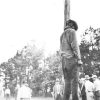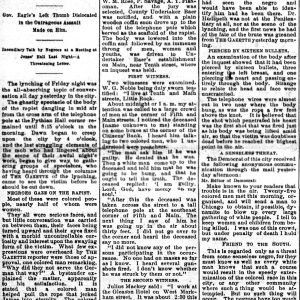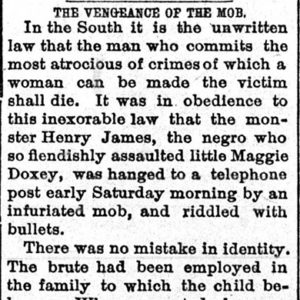calsfoundation@cals.org
Henry James (Lynching of)
On May 14, 1892, Henry James was lynched in Little Rock (Pulaski County) for an alleged assault on five-year-old Maggie Doxey. According to the Arkansas Gazette, it was the first time in twenty years that “Little Rock [had] witnessed a mob or an attempt at enforcing mob law in this city.”
James, described in some newspapers as a twenty-two-year-old “mulatto,” was originally from Augusta, Maine, but had moved south three years earlier. He worked for a time as a waiter in Hot Springs (Garland County), but for the two weeks prior to his murder, he had been working for the family of Charles Johnson in Little Rock. According to the Arkansas Gazette, the family found him to be “a faithful and honest servant,” who was especially fond of their adopted daughter, Maggie Doxey. He “constantly played with and humored her, and she loved him because of his kindness.” On Tuesday morning, May 10, the Johnsons were in Hot Springs, leaving Maggie in the care of her maternal grandmother, Mrs. Pennington, who lived with them. When Maggie’s mother returned on the afternoon train, Mrs. Pennington told her that James had assaulted the child, though the details of this supposed assault are not relayed in any of the reports. Johnson contacted Mayor H. L. Fletcher, who sent Detective Dave Adams to the home, only to find that James had left. Adams advised the family to contact James and to tell him that if he returned to their home, they would not punish him. James returned, and Adams came to the Johnsons’ house to arrest him, finding the “saddle-colored fiend” on the back porch. When questioned, James admitted being in the kitchen with Maggie on Tuesday but denied having her sit upon his lap, as was alleged.
Despite his denials, he was taken to the county jail. Citizens were enraged, apparently believing that, under Arkansas law at the time, an assault on such a young child was not considered a rape, and James, if convicted, would get a maximum sentence of only twenty-one years in jail. After they threatened to lynch him, James was secretly taken to the state penitentiary by Deputy Sheriff James Heard. On the evening of May 13, a crowd gathered at the county jail, intending to remove James and lynch him. Discovering that he was not in the jail, part of the crowd dispersed, but others went to see if he was in the penitentiary.
Hearing of the mob’s approach, penitentiary manager Colonel S. M. Apperson, instructed the guards to go to their quarters and said that he himself would meet the mob. When the crowd reached the penitentiary around 11:00 p.m., Apperson informed them that James would be moved back to the county jail at 8:00 the following morning. Members of the mob originally named a group of men to stay at the penitentiary to make sure that James was not moved again during the night.
In the meantime, however, the crowd continued to grow. Despite Apperson’s refusal to turn over James, and despite his warnings that they should wait until morning rather than attack a state penitentiary, the mob broke into the gates and sent six men inside to find James. By the time they found him and broke down the doors of the cell house, it was 12:45 a.m. on May 14. The crowd took James to the corner of 5th and Main and gave him an opportunity to confess, which he declined to do. He was allowed to pray, “and finally said, when questioned as to his guilt: ‘I guess I am guilty.’” For some reason, the mob then moved him to the corner of the Pythian Hall, slung a rope over the arm of a telephone pole, and lynched him. James’s body had only risen partway off the ground before a volley of at least 100 shots was fired into it.
Governor James Philip Eagle happened to be passing through town as the last shots were fired. He arrested the man who fired the last shot, but the mob turned on him, rescued the prisoner, and knocked Eagle down. While Eagle’s friends saved him from serious injury, he did sustain a sprained hand in the scuffle. James’s body remained hanging from the pole until 8:15 in the morning, attracting large crowds, described by the Gazette as mostly African Americans, nearly half of whom were women. According to the report, “The colored people were thoughtful, rather than demonstrative or argumentative.”
Before James was cut down, a photographer named Davies climbed to a portico at the corner of the Pythian Hall, waiting to take his pictures until Coroner Bond arrived, “that he might have some one steady the swinging limbs that the picture might not be blurred.” At 8:15, the body was cut down, put in a coffin, and taken to Baer’s undertakers, “followed by an immense throng of men, women, and youths.” Two witnesses appeared at the coroner’s inquest, one describing James’s confession and saying that he did not recognize anyone in the crowd, although none of them were wearing masks. The second witness had little to add. The jury determined that James had died “by hanging and shooting at the hands of some person or persons to the jury unknown.”
In the meantime, spectators rushed to get pieces of the rope used to hang James, and someone carved his name on the telephone pole. According to the Gazette, “As long as this pole stands there will be an element of superstition in its very presence to the ignorant.” Governor Eagle reportedly declared that if he had come on the scene earlier and had been unable to stop the lynching, “he would at least have attempted, if the mob would hang the negro, not to have done it on the principal street of the Capitol [sic] City.”
The Gazette defended the lynching, declaring that, “There are times when that higher law which discards legal forms, and marches in a straight line to the execution of its awful decrees, supersedes all other tribunals. The brute who assaulted little Maggie Doxey yielded his worthless life to this higher law. His crime was the most atrocious of all crimes; and however we may deplore the methods of the mob, who will say he did not deserve his fate?” Reports in the Bismarck Daily Tribune and the Indiana State Sentinel indicate that Maggie Doxey died of her injuries several days after James was lynched.
The Appeal, an African-American newspaper published in St. Paul, Minnesota, had some questions to ask about these events, however: “Does any fair-minded person suppose there was any actual desire on the part of the authorities to prevent the mob at Little Rock, Ark., from breaking into the penitentiary and taking therefrom Henry James the Afro-American accused of outraging the little white girl last week? The guards in that penitentiary could have kept a mob of 10,000 at bay for an indefinite period. Does any fair-minded person believe that had Henry James been white and Maggie Doxey black and the circumstances otherwise exactly the same that there would have been any such exhibition in the defence [sic] of outraged virtue by the ‘superior race’? Would a black Maggie Doxey at five years of age been any less pure than a white one? Would an assault on a black virgin five years old by a letcherous [sic] white brute been any less aggravating than if the colors were reversed? Did anybody ever hear of a white mob lynching a white man for outraging a black virgin? Why cannot a black man be tried in the legal courts? If there is any doubt of his innocence, he will get the benefit of the doubt….If an insurrection a thousand-fold greater than the Nat Turner insurrection should break out in the South who would be to blame?”
For additional information:
“He’s Gone: No Longer Will the Lecherous Beast Indulge His Lust upon Earth.” Arkansas Gazette, May 14, 1892, p. 1.
Lancaster, Guy. “Before John Carter: Lynching and Mob Violence in Pulaski County, 1882–1906.” In Bullets and Fire: Lynching and Authority in Arkansas, 1840–1950, edited by Guy Lancaster. Fayetteville: University of Arkansas Press, 2018.
“A Night’s Work.” Arkansas Gazette, May 15, 1892, p. 1, 3.
“Some Questions.” The Appeal (St. Paul, Minnesota), May 21, 1892, p. 2.
Nancy Snell Griffith
Clinton, South Carolina
 Carter, John (Lynching of)
Carter, John (Lynching of) Civil Rights and Social Change
Civil Rights and Social Change Post-Reconstruction through the Gilded Age, 1875 through 1900
Post-Reconstruction through the Gilded Age, 1875 through 1900 James Lynching Article
James Lynching Article  James Lynching Editorial
James Lynching Editorial 




Comments
No comments on this entry yet.